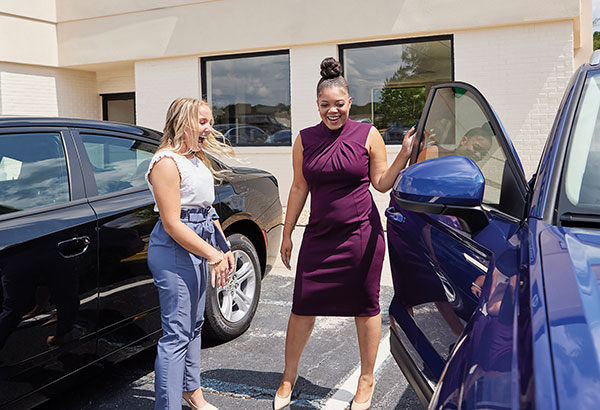Live Better
Career ready: 3 strategies to prepare teens for life after school

(Family Features) For some time, heading to college or joining the workforce have been the standard choices for teens upon high school graduation. Today, in part due to technology and social media, students have access to myriad career paths that are all but traditional.
With an increasingly dynamic career landscape creating an awareness of jobs that didn’t exist even 10 years ago and a shortage in the workforce, there’s a willingness for both potential employees and employers to look at careers and young talent from a whole new perspective.
“There isn’t a ‘typical’ career anymore,” said Dr. Lorna Bryant, Gen Z career expert and head of career education for Pearson Virtual Schools. “With the perfect storm in the workforce of boomers retiring, many people still not returning to work in the wake of the pandemic and a population that has declined for the last 50 years, this generation (ages 11-26) is positioned extremely well. Employers want and need them. In short, the scales have flipped to the supply side and demand is causing many employers to remove barriers to work entry. Whether high school grads go to college or work, developing in-demand skills early will help them secure and succeed in the jobs of the future.”
Consider these tips from Bryant to help students explore the many options in front of them and prepare for the possibilities that await after high school.
Help Kids Cultivate Durable Skills
While technology has transformed the world of work, an increasing number of careers prioritize durable skills over technical or hard skills. Durable skills (also known as “soft” or “human” skills) include collaboration, leadership, communication and attention to detail, along with traits like empathy, grit and resilience. According to Pearson’s Power Skills report, these are some of the most in-demand skills for employers. In addition, research from America Succeeds found employers seek durable skills 3.8 times more frequently than the top five technical or hard skills in every location, industry sector and educational attainment level. Possessing these skills is not only attractive to employers but colleges and universities, too. One of the best ways to prepare for the jobs of tomorrow, which don’t exist today, is to focus on timeless durable skills.
Many students already possess or are actively developing these skills in high school. The key is to raise awareness of their importance, seek ways to boost them and showcase them on college and job applications or resumes. For example, teens can display their leadership skills by captaining sports teams or starting a club at school. They can showcase collaboration and communication abilities by holding and thriving in student government positions, volunteering or working part-time jobs.
Bridge Passions and Hobbies to Careers
Beginning conversations with children as early as middle school that expose students to job roles, responsibilities and salaries connected to areas of interest is important for setting them up for long-term success. Nurturing interests – rather than dismissing them as flights of fancy – and finding paths to explore that align with those hobbies or interests in real-world applications can open doors to potential careers that may not have previously been considered.
For example, Lake Liao, a 2023 Lighthouse Connections Academy grad, is attending Princeton University on a pre-law track. The flexibility of online school enabled him to dig into his passions for political and community organizing and activism in high school, including activism around climate and environmental policy. It was through joining local nurses in their fight for a fair contract he realized he wanted to be a lawyer and make a difference in the labor rights cause.
To help students align their values and interests with potential careers, ask questions such as:
- What is it, specifically, you enjoy about your interests? What jobs rely on related skills (working with your hands, serving others, being creative, etc.)?
- Do you have the skills to do those jobs? If not, what research and training do you need to acquire the necessary skillset?
- Are there related jobs available in the geographic location you want to live?
- Can you make enough money to live the lifestyle you want doing this job?
- Can you envision enjoying this type of work for 8 (or more) hours per day?
Get a Head Start on Credentials or College Credit
As earning college credits, career-ready credentials and specialized training for future careers is becoming more accessible for high school and middle school students, it’s important to research available options. From online resources, workshops, career counselors and accelerated career readiness programs that allow students to enter college or the workforce “job-ready,” there are more options available now than ever before.
One example, Connections Academy, a K-12 online school program, has expanded its slate of college and career readiness initiatives for middle and high school students to offer an innovative tri-credit approach where courses can deliver high school credit; industry-recognized micro-credentials (to help qualify for careers in data analytics, UX design, software development, cybersecurity and more); and eligibility for college credit toward more than 150 bachelor’s degree programs at partner universities in the United States. In addition, the Career Pathways program delivers curated learning experiences in fields such as IT, business and health care, allowing students to connect with employers, internships and clubs, and take advantage of specialized classes that transition seamlessly to higher education or nationally recognized, industry certifications.
Taking advantage of program offerings, aspiring paramedic Maeson Frymire, a 2022 Inspire Connections Academy graduate, became certified as an EMT before graduating high school. After graduation, he became a firefighter and is now working toward becoming an advanced certified EMT, carving out a career path toward flight paramedicine.
Or consider Abigail Sanders, also a 2022 graduate, who completed her bachelor’s degree by the time she graduated high school. Now in the second year of her doctorate program in medical school, she aspires to be a doctor by the age of 22 and uses her love of learning and passion for science to advance her career while seeking to become an oncologist.
For more information on online schools and career readiness programs for teens, visit ConnectionsAcademy.com.
Photos courtesy of Getty Images
SOURCE:
Connections Academy
Live Better
Turn your tax refund into a new ride

Make a major purchase more manageable
(Family Features) With tax refunds starting to flow in, many people are considering ways to invest their money.
If you’re looking to purchase a vehicle, putting your tax refund toward a down payment on a used car can be a smart financial decision for several reasons – from reduced interest rates on your loan and shortened loan terms to lower monthly payments – and the timing is right to take advantage of improving market conditions. Consider this information to help make an informed buying decision.
Lower Your Monthly Payment
The more you can invest in the down payment of a vehicle, the lower your monthly cost will typically be and the less interest you will typically pay over the length of the loan. This can lead to smaller, more manageable monthly payments.
A significant down payment can also help offset higher-than-average interest payments and could lead to a shorter term, meaning less total accrued interest. An auto loan calculator can show you how a down payment can affect interest charges.
More Affordable Vehicle Options Used car prices have been trending downward month-over-month, according to the Bureau of Labor Statistics’ consumer price index. These decreases in used car prices are helping offset higher than normal interest rates. The average sales price for a pre-owned vehicle through Enterprise Car Sales, for example, is approximately $21,000 right now, compared to average new car prices, which are hovering around $44,000.
Used car prices have been trending downward month-over-month, according to the Bureau of Labor Statistics’ consumer price index. These decreases in used car prices are helping offset higher than normal interest rates. The average sales price for a pre-owned vehicle through Enterprise Car Sales, for example, is approximately $21,000 right now, compared to average new car prices, which are hovering around $44,000.
Vehicle inventory is improving along with an increase in consumer demand for cars, which makes now an attractive time to buy. Many used car sellers feature inventory that is readily available so you can select from options you know are in stock, including different makes and models with a wide range of different features that can offer more affordable options.
“We have a large inventory of vehicles across the country currently priced under $20,000,” said Mike Bystrom, vice president of Enterprise Car Sales. “There are several considerations to keep in mind when shopping for a vehicle, and there is no one-size-fits-all approach. Consumers should weigh their options, but the one thing they shouldn’t compromise on is receiving great customer service.”
Protect Your Purchase
Ensuring your purchase is protected is also a smart financial decision. Take advantage of dealers that offer additional benefits to help protect your purchase and provide peace of mind that your tax refund has been well spent.
Look for a used vehicle that has passed an inspection by an ASE-certified technician and comes with a limited powertrain warranty, as well as extra coverage options such as roadside assistance and a return policy up to a certain amount of days or mileage.
With a little research and careful planning, you can find a reliable used car that meets your needs and puts your tax refund to good use. Visit enterprisecarsales.com for more information.
SOURCE:
Enterprise Car Sales
Live Better
Get ready to grill: Choosing the right outdoor cooking solution

(Family Features) Warmer temperatures and sun-filled days mean it’s time to take entertaining and socializing outdoors, and a key component of many outdoor gatherings is fresh-grilled food.
Because firing up the grill can make prepping meals quick and easy, it allows you to spend more time with friends and family rather than missing out on the sunshine while stuck in the kitchen. Whether you’re a first-time griller or consider yourself a master of the grates, there’s a grill available to meet your skill level and needs, such as these options that provide flexibility for small-to-midsize backyard spaces – as well as a large built-in model for custom outdoor kitchens – and a variety of features and function to make the most of your warm weather gatherings.

Portable, Small-Space Cooking
Ideal for first-time grillers, couples, small families or those with limited backyard spaces, the Megamaster 3-Burner Gas Grillwas designed to fuse performance and value. Despite its size, it can cater to almost any grilling or entertaining need with three stainless steel burners and 447 square inches of cooking space, a combination of versatility and capacity to prepare large quantities of food as well as various types of food simultaneously. Plus, it’s easy to maneuver on two heavy-duty wheels, making it simple to free up patio space after use. Learn more at megamaster.com.

Family-Sized Functionality
With ample cooking space to feed small and medium-sized groups, the Nexgrill 4-Burner Gas Grill with Side Burner is a perfect all-around grill for both beginners and seasoned grilling enthusiasts. Always ready to fire up some flavor, the durable grill also features a stainless steel side burner to saute, simmer and warm dishes simultaneously as well as 628 square inches of cooking space, meaning family favorites like burgers, dogs, chicken and more can be put on the table quickly. Find more information at nexgrill.com.

Elevate Your Outdoor Kitchen
If your outdoor living area includes enough space, you can elevate the outdoor cooking experience with an outdoor kitchen. Put a premium, built-in grill like the Spire 6-Burner Built-In Grill at the center of your custom, luxurious entertaining space. This dual-fuel, stainless steel gas grill features 904 square inches of cooking space and 73,000 British thermal units of cooking power across six main burners and an intense-heat ceramic rear burner, producing restaurant-quality sear marks and exceptional heat retention. Visit spireoutdoor.com to learn more about the durable, high-performance grilling solution.
SOURCE:
Megamaster
Nexgrill
Spire
Live Better
Tips to make your AC more energy efficient, sustainable

(Family Features) Updating your HVAC (heating, ventilation and air conditioning) system to cool your home in a smart and sustainable way involves several steps that not only improve energy efficiency but also reduce environmental impact.
Consider these tips from the heating and cooling experts at Carrier to help make your cooling system more eco-friendly:
- Upgrade to an Energy-Efficient HVAC System. If your HVAC system is outdated, consider replacing it with a more energy-efficient model. Look for systems with an Energy Star or high SEER2 (seasonal energy efficiency ratio) rating, which indicates better energy efficiency. The higher the SEER2 rating, the more efficient the unit. Financial incentives for installing a higher-efficiency system are available through the Inflation Reduction Act of 2022. You can also shop for rebates from manufacturers and utility companies.
- Look for a Carbon-Free HVAC System. Heat pumps, ductless and VRF (variable refrigerant flow) systems that run on electricity and use low global-warming potential refrigerant, like Carrier’s Puron Advance, can help reduce your home’s negative impact on the environment.
- Install a Smart Thermostat. A smart thermostat can be programmed based on your preferences and adjust temperatures automatically. These devices can be controlled remotely through smartphones and help reduce energy consumption by cooling your home only when necessary.
- Conduct Regular Maintenance. Keep your HVAC system running efficiently with regular maintenance. This includes cleaning or replacing air filters every 1-3 months, checking refrigerant levels, cleaning outside condenser coils and ensuring the system’s components are in good, working condition and the airflow is not blocked.
- Seal and Insulate. Improve your home’s insulation to maintain a consistent temperature. Seal windows, doors and any gaps or cracks to prevent cool air from escaping. This can significantly reduce the workload on your HVAC system.
- Use Ceiling Fans. Ceiling fans can help circulate cool air throughout your home, allowing you to set the thermostat at a higher temperature without sacrificing comfort, thus saving energy.
- Add Window Treatments. Use blinds, shades or curtains to block out sunlight and reduce heat gain during the hottest parts of the day. This simple step can make a big difference in how much your air conditioner needs to work.
- Upgrade to a Variable-Speed Compressor. Traditional compressors operate at full power or not at all. However, a variable-speed compressor can adjust its output to match your cooling needs precisely, resulting in better efficiency, energy savings and improved indoor comfort.
- Ventilate Properly. Ensure proper ventilation in your home, especially in areas like the kitchen and bathroom, to remove excess heat and humidity, which can reduce the need for air conditioning.
- Update Roofing. If you’re replacing your roof, consider cool roofing materials that reflect more sunlight and absorb less heat than standard roofing materials, reducing the heat that enters your home.
By implementing these strategies, you can improve or update your HVAC system to cool your home more sustainably. Not only do these steps help the environment, they can also lead to lower energy bills and improved indoor comfort. Always consult with an HVAC professional to determine the best and most efficient options for your home and needs.
Find more information and tips to sustainably cool your home at Carrier.com.
SOURCE:
Carrier
-

 NEWS1 year ago
NEWS1 year ago2 hurt, 1 jailed after shooting incident north of Nocona
-

 NEWS6 months ago
NEWS6 months agoSuspect indicted, jailed in Tia Hutson murder
-

 NEWS1 year ago
NEWS1 year agoSO investigating possible murder/suicide
-

 NEWS1 year ago
NEWS1 year agoWreck takes the life of BHS teen, 16
-

 NEWS9 months ago
NEWS9 months agoMurder unsolved – 1 year later Tia Hutson’s family angry, frustrated with no arrest
-

 NEWS1 year ago
NEWS1 year agoSheriff’s office called out to infant’s death
-

 NEWS1 year ago
NEWS1 year agoBowie Police face three-hour standoff after possible domestic fight
-

 NEWS1 year ago
NEWS1 year agoDriver stopped by a man running into the street, robbed at knifepoint





